Executive Summary
AI document review has transformed from basic OCR (yes, even OCR is a form of AI) to sophisticated analysis that matches human expertise in specific domains. For most organizations, the ideal solution isn’t a single general-purpose AI but specialized tools aligned with your document types and workflow requirements. Focused, domain-targeted AI solutions like Leah by ContractPodAi offer superior performance for agreement analysis, with a suite of various tools to handle your most difficult legal matters. This guide helps you evaluate AI document review solutions based on accuracy, specialization, security, and ROI to match your unique organizational needs. The market has matured significantly since 2020, with domain-trained AI now demonstrating expert-level competence in specialized document analysis.
Market Evolution: From OCR to Intelligent Document Analysis (2015-2025)
The journey of AI document review has been remarkable over the past decade. What began as simple text extraction has evolved into sophisticated analysis that can understand context, identify obligations, and even suggest improvements.
2015-2018: The OCR+ Era
Early solutions relied primarily on optical character recognition with basic pattern matching. Pioneering companies like Kira Systems and eBrevia introduced rudimentary machine learning to identify specific clauses in contracts, but accuracy remained inconsistent, requiring extensive human validation.
2019-2021: Machine Learning Specialization
This period saw the rise of domain-specific AI trained on particular document types. These systems improved accuracy by focusing on narrow use cases – contracts, legal briefs, or compliance documents – rather than attempting general document comprehension.
2022-2023: Large Language Model Integration
The introduction of GPT-3 and similar models revolutionized document review by bringing broader contextual understanding. However, these general models lacked the specialized knowledge needed for complex document analysis without significant fine-tuning.
2024-2025: Domain-Specific LLMs with Expert-Level Capabilities
Today’s leading solutions combine specialized training with advanced LLM capabilities. Systems like Leah don’t just extract information – they understand nuanced contractual implications, identify risk patterns across entire portfolios, and integrate seamlessly with workflow systems.
These agentic AI systems can autonomously navigate complex legal workflows, make contextual decisions about contract modifications, and proactively flag potential compliance document issues without constant human oversight. The shift toward agentic capabilities means these tools now operate more like specialized legal agents that can take initiative, rather than passive information processors waiting for specific queries.
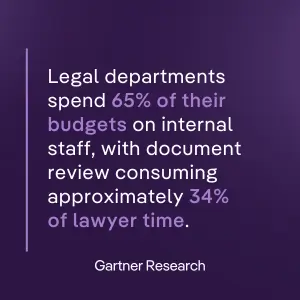
Why Traditional Document Review Falls Short
While AI capabilities have evolved dramatically, many organizations remain stuck in outdated manual processes that create compounding challenges. The contrast between what’s possible with modern AI and the reality of traditional review methods highlights an urgent need for transformation.
Below we dive into some of the outdated processes holding up organizations:
Unsustainable Costs
According to Gartner research, legal departments spend 65% of their budgets on internal staff, with document review consuming approximately 34% of lawyer time. For a mid-sized legal team, this represents hundreds of thousands in annual costs for tasks that modern AI can perform more efficiently.
Human Error and Inconsistency
The Association of Corporate Counsel (ACC) reports that manual contract review produces inconsistent results with error rates between 15-25%, especially during high-volume periods or when conducted by junior staff. These errors create downstream business risks and potential compliance issues.
Productivity Bottlenecks
Document backlogs delay business operations and strategic initiatives. Traditional review processes simply cannot scale with the growing volume of documents that modern businesses generate, with ACC benchmarking showing that manual review takes 3-5× longer than AI-assisted review for typical contracts.
Lost Strategic Insights
Perhaps most significantly, traditional review methods treat documents as isolated items rather than connected data points. This approach misses valuable trend analysis and predictive insights that modern AI systems can generate from document collections.
These limitations make clear why forward-thinking organizations are rapidly adopting AI solutions that address each of these pain points systematically.
Core Evaluation Criteria for Document Review AI
Understanding the limitations of traditional review helps clarify what to look for in modern AI solutions—but not all systems are created equal. When assessing AI review solutions, focus on these critical factors:
Accuracy and Domain-Specific Training
The foundation of any effective document review AI is its accuracy within your specific domain. Domain-trained systems are fine-tuned to understand specialised terminology and nuanced contextual implications that generic AI models may overlook. Benchmark accuracy rates for contract analysis should exceed 90% for key clause identification.
Integration Capabilities
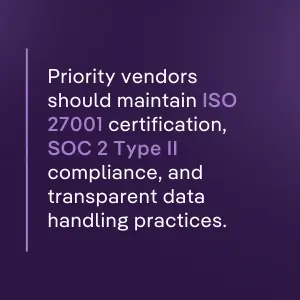
Document review rarely exists in isolation. The best AI solutions integrate seamlessly with your existing document management systems, communication tools, and workflow platforms. Look for systems with robust APIs and pre-built connectors to your technology stack.
Security and Compliance
Document review often involves sensitive information. Priority vendors should maintain ISO 27001 certification, SOC 2 Type II compliance, and transparent data handling practices. Evaluate whether the solution offers on-premises deployment options or secure cloud environments with appropriate data residency controls.
Total Cost of Ownership
Beyond the initial license fees, calculate implementation costs, training requirements, and ongoing management overhead. The most cost-effective solutions may not have the lowest upfront price but will deliver greater long-term ROI through superior accuracy and reduced manual review needs.
Scalability and Performance
Document volumes fluctuate with business cycles. Effective AI systems maintain performance under peak loads without significant degradation in processing speed or accuracy. Test solutions with your typical document volumes and diversity to ensure consistent performance.
Cross-Industry AI Leaders: General Document Analysis
With evaluation criteria in hand, let’s examine how today’s leading general-purpose AI platforms perform in document review scenarios.
These familiar names offer impressive capabilities that may surprise organizations still relying on manual processes:
ChatGPT-4o (OpenAI)
OpenAI’s latest model excels at understanding document context and can analyze a wide range of document formats, including PDFs with tables and images. Its strengths include excellent comprehension of complex documents and the ability to summarize lengthy materials accurately. However, it lacks domain-specific training for specialized fields like legal contracts and doesn’t integrate natively with document management systems.
Claude 4 Opus (Anthropic)
Claude’s document analysis capabilities show particular strength in extracting nuanced meaning and identifying inconsistencies within documents. Its 200,000 token context window allows for analyzing longer documents without losing context. Like ChatGPT, Claude requires customization for specialized document types and lacks built-in workflow integration.
Gemini Pro (Google)
Google’s offering provides strong multilingual document analysis and excels at processing documents with mixed content types (text, tables, and images). Its integration with Google Workspace creates workflow advantages for organizations already in that ecosystem, though its specialized domain knowledge lags behind purpose-built solutions.
While these platforms can handle general document review tasks admirably, they typically require significant prompt engineering and lack the specialized training that purpose-built solutions offer for specific document types.
Contract-Focused AI: Purpose-Built Solutions
For organizations dealing primarily with contracts and legal agreements, the performance gap between general and specialized AI becomes particularly pronounced. Purpose-built contract AI solutions bring decades of legal expertise encoded into their algorithms, delivering accuracy and insights that general tools simply cannot match.
Below, we explore some of the leaders in contract analysis.
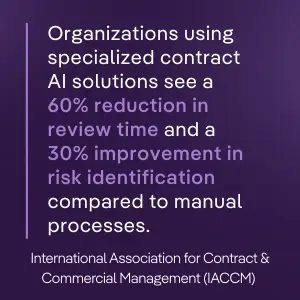
Leading Contract Analysis Solutions
According to Forrester Research, the most effective contract analysis platforms offer a combination of machine learning and specialized training on legal documents. The International Association for Contract & Commercial Management (IACCM) reports that organizations using specialized contract AI solutions see a 60% reduction in review time and a 30% improvement in risk identification compared to manual processes.
Top solutions in this space share several key characteristics:
- Industry-leading accuracy on clause extraction (95%+ in benchmark tests conducted by MIT)
- Automatic risk scoring based on organizational risk profiles
- Seamless integration with contract lifecycle management workflows
- Multilingual analysis capabilities across major business languages
- Customizable analysis parameters to align with organizational priorities
Pattern Recognition Solutions
Research from Stanford Law School’s CodeX center demonstrates that pattern-recognition approaches to contract analysis using unsupervised machine learning are particularly effective for due diligence and M&A work where identifying outlier contractual terms is critical.
Legal Drafting Assistance
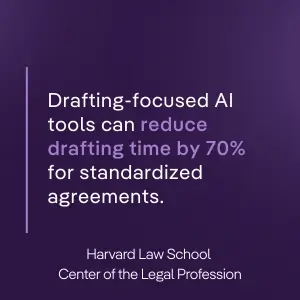
According to the American Bar Association’s legal technology survey, drafting-focused AI tools show increasing adoption among legal professionals, with integration into word processing platforms creating seamless experiences. The Harvard Law School Center on the Legal Profession notes that these tools can reduce drafting time by up to 70% for standardized agreements.
Regulated-Industry Adapters: Specialized Compliance Solutions
Beyond contracts, certain industries face unique regulatory requirements that demand even more specialized AI approaches. Healthcare, financial services, and real estate each present distinct challenges that generic solutions struggle to address effectively:
Healthcare: Adapting to HIPAA and Clinical Requirements
Healthcare document review must address both regulatory compliance and technical medical content. According to AHIMA (American Health Information Management Association), specialized models trained on healthcare agreements can recognize HIPAA-required provisions and common compliance pitfalls in provider contracts and research agreements. The Journal of AHIMA has published studies showing that healthcare-specific AI solutions improve compliance verification by up to 30%.
Financial Services: Navigating Complex Regulatory Frameworks
Financial institutions must review documents within interconnected regulatory frameworks including SOX, GLBA, and evolving international standards. The Financial Industry Regulatory Authority (FINRA) reports that AI systems specifically trained on financial documentation, with built-in regulatory checklists, can ensure compliance across jurisdictions while reducing review time by 50-60%.
Real Estate: Managing Property-Specific Documentation
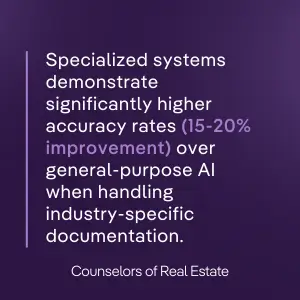
Real estate transactions involve unique document structures from leases to environmental assessments. The Journal of the American Real Estate Society has documented how specialized solutions provide accurate analysis of property documentation, including complex lease abstraction and compliance verification for property management documentation.
According to the Counselors of Real Estate, these specialized systems demonstrate significantly higher accuracy rates (15-20% improvement) over general-purpose AI when handling industry-specific documentation.
Governance & Responsible AI: Ensuring Ethical Document Review
As powerful as these AI solutions are, their implementation must be guided by robust governance frameworks to ensure ethical and responsible use. Without proper oversight, even the most advanced AI can introduce new risks while solving old problems.
Below, we discuss appropriate governance frameworks:
Bias Testing and Mitigation
Document review AI can perpetuate or amplify biases present in training data. Leading organizations implement regular bias testing frameworks based on NIST AI standards, testing system outputs across different document types and content to identify problematic patterns.
Transparency and Explainability
Effective document review requires understanding how AI reaches its conclusions. Solutions should provide clear confidence scores for extracted information and maintain comprehensive audit logs of system decisions and human overrides.
Human Oversight Integration
Responsible implementation requires clear processes for human review of AI outputs, particularly for high-risk documents. Design workflows with appropriate validation checkpoints based on document risk levels and confidence scores from the AI system.
Security & Privacy: Protecting Sensitive Document Data
Governance extends beyond ethics to encompass the critical security considerations that document review inherently demands. When AI systems process your most sensitive documents, security architecture becomes as important as analytical capabilities.
Data Protection Approaches
Leading solutions offer multiple deployment options to address security requirements:
- Zero-trust cloud environments with end-to-end encryption
- Private cloud deployments in specific geographic regions for data residency compliance
- On-premises options for organizations with strict data control requirements
Platform Security Credentials
Beyond basic security certifications, evaluate the provider’s security architecture and incident response capabilities. Azure OpenAI and AWS Bedrock deployments provide additional security layers for AI document processing, while ensuring proper data isolation.
Data Usage Commitments
Verify whether your documents might be used to train the vendor’s AI systems. Leading providers now offer clear contractual commitments against using customer documents for model training purposes.
Cost & ROI Framework: Calculating the Business Case
With security addressed, organizations need a clear framework for evaluating the financial implications of AI document review adoption. The true value extends beyond simple cost savings to include risk reduction, acceleration benefits, and strategic insights previously impossible to obtain
Building the business case for AI document review requires a comprehensive ROI analysis:
Cost Structure Components
- Implementation costs (integration, customization, and training)
- Ongoing license fees (per-user, per-document, or enterprise models)
- Internal staff time for system management and oversight
- Training and change management expenses
ROI Calculation Framework
Effective ROI analysis should consider:
- Direct labor cost reduction (attorney/staff hours saved × average hourly cost)
- Risk reduction value (potential cost avoidance from improved accuracy)
- Acceleration benefits (revenue impact of faster document processing)
- Strategic value (insights gained from comprehensive document analytics)
Best Practices for Implementation
This infographic outlines an 8-phase framework for implementing generative AI in legal teams, covering everything from forming an AI team and identifying use cases to selecting solutions and establishing ongoing evaluation processes.

Vendor RFx Checklist: Essential Questions
Before committing to any vendor, use this comprehensive checklist to ensure your chosen solution meets all critical requirements. When evaluating AI document review vendors, address these critical questions:
Technical Capabilities
- What document types and formats does the system support?
- How was the AI trained, and on what document corpus?
- What is the accuracy rate for key information extraction?
- How does the system handle exceptions and low-confidence extractions?
Integration and Workflow
- What pre-built integrations exist for common business systems?
- How robust is the API for custom integrations?
- What workflow automation capabilities are included?
- How are system outputs delivered to end-users?
Security and Compliance
- What security certifications does the platform maintain?
- Where is data processed and stored?
- What encryption standards are implemented?
- How are user access controls managed?
Commercial Terms
- What pricing model is used (per-user, per-document, enterprise)?
- What implementation services are included?
- What ongoing support and training are provided?
- What service level agreements are offered?
Vendor Stability
- What is the company’s financial position and funding status?
- How frequently are updates and new features released?
- What is the product roadmap for the next 12-24 months?
- What is the customer retention rate?
Tool-Picker Matrix: Finding Your Best Match
To simplify your decision-making process, here’s a comparative overview of leading solutions mapped to specific use cases and requirements.
| Solution | Best For | Distinguishing Feature | Integration Capability | Cost Range |
|---|---|---|---|---|
| ContractPodAi Leah | Contract management and deep analysis | Highest clause extraction accuracy with embedded legal expertise | Extensive (CRM, Office suites, management platforms) | $$ |
| Microsoft Copilot | General document understanding | AI-powered document analysis with Office integration | Extensive (Microsoft ecosystem, CRM platforms) | $$ |
| Google Workspace AI | M&A due diligence | Pattern recognition across document collections with cloud collaboration | Moderate (Google Workspace, enterprise systems) | $$ |
| LexisNexis+ | Legal research and case preparation | Integration of case documents with legal research database | Limited (focused on legal research platforms) | $ |
| ChatGPT | General document understanding | Flexible application to diverse document types | Limited (requires custom integration) | $ |
| Claude | Long document analysis | Extended context window for comprehensive document analysis | Limited (requires custom integration) | $ |
| Amazon Textract | Healthcare contract management | OCR and form processing with compliance focus | Moderate (AWS ecosystem, healthcare systems) | $$ |
| Harvey | Legal Document Review | User-friendly interface, strong dashboard/reporting, effective | Integrates + partnered with Icertis | $$ |
FAQ and Glossary
Frequently Asked Questions
How accurate are AI document review systems compared to human review?
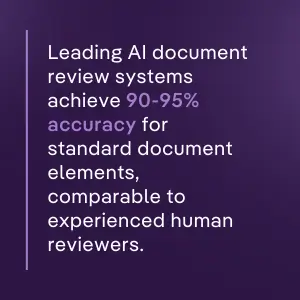
Leading AI document review systems achieve 90-95% accuracy for standard document elements, comparable to experienced human reviewers. For specialized fields like legal contract analysis, domain-trained AI often outperforms junior lawyers while still requiring expert oversight for complex or novel issues.
What types of documents work best with AI review?
AI performs best on standardized documents that follow consistent structures – contracts, financial statements, regulatory filings, and technical specifications. Free-form documents like creative briefs or complex scientific papers typically require more human interpretation.
How long does implementation typically take?
Many AI-powered solutions offer out-of-the-box functionality that can be used on day one — for example, Leah provides immediate contract analysis capabilities without lengthy setup periods.
Do AI review systems require ongoing training?
AI review systems require ongoing training to remain effective as language patterns and business contexts evolve. Choose vendors that continuously update their models using diverse external datasets rather than relying on your customer data, which protects your privacy while ensuring broader accuracy. Vendors dependent on customer data for training create security risks and may develop models too narrowly focused on your specific use cases.
What’s the difference between general AI like ChatGPT and specialized document review AI?
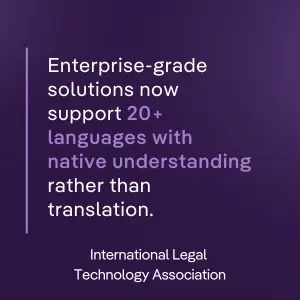
Specialized document review AI is trained extensively on specific document types and incorporates domain expertise that general AI lacks. Stanford University’s AI Index Report shows that while general LLMs can understand documents broadly, specialized systems understand the specific implications of contractual language and regulatory requirements, with domain-specific models showing 25-40% better performance on specialized tasks.
Can AI review systems handle multiple languages?
Leading systems support major business languages. The International Legal Technology Association (ILTA) annual technology survey shows that enterprise-grade solutions now support 20+ languages with native understanding rather than translation. Language capabilities vary significantly between vendors, so organizations with multilingual requirements should test systems with their specific language needs.
Glossary of Key Terms
Extraction Accuracy
Percentage of correctly identified data points compared to human expert review.
False Positive
When AI incorrectly identifies text as a relevant data point.
False Negative
When AI fails to identify a relevant data point.
OCR (Optical Character Recognition)
Technology that converts images of text into machine-readable text.
Named Entity Recognition (NER)
AI technique that identifies and classifies key elements in text into predefined categories.
Document Classification
Automated categorization of documents into defined types based on content analysis.
Confidence Score
Numerical indication of the AI’s certainty in its extraction or classification.
Supervised Learning
AI training method using human-labeled examples to teach the system.
Redlining
Process of tracking changes and suggesting modifications to document text, particularly in contracts.
Large Language Model (LLM)
Neural network trained on vast text data that can understand and generate human-like text.
Finding Your Ideal AI Document Review Solution
The right AI document review solution depends on your specific requirements, document types, and organizational objectives. While general-purpose AI has made impressive advances, domain-specific solutions still provide significant advantages for specialized document types, particularly in regulated industries and complex contractual analysis.
Organizations achieve the best results by starting with a clear understanding of their document review challenges, establishing concrete success metrics, and implementing solutions through phased approaches that build user confidence and demonstrate measurable ROI.
Ready to transform your document review process? Book a demo today.


